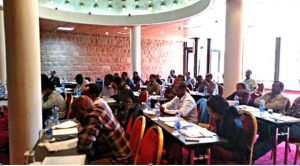Executives from the Ethiopian Electric Utility (EEU) participated in a USAID and Power Africa-funded workshop, organised by the World Energy Council’s ber , the United States Energy Association (USEA), that focused on improving utility performance and solvency. The participants met with their peers from utilities, and meter and software manufacturers to learn about technologies and techniques for improving distribution utility performance.
The workshop highlighted three critical topics: the importance of loss reduction to system stabilisation; the relationship among smart metering, AMI and revenue enhancement; and billing and collections best practices, prepayment systems and new technologies.
Participants discussed a range of issues, including strategies for reducing technical losses, combatting electricity pilferage and meter tampering, and new information and data analysis technologies. Participants also learned about the importance of customer service and proactively engaging the community to achieve loss reduction targets and protect the utility’s revenue over the long-term.
Masresha Asfaw from EEU discussed the status of Ethiopia’s distribution system, and the utility’s loss reduction programs, and billing system. Current challenges at EEU include theft, meter tampering, aging, obsolete or faulty transformers, switch gear, and other distribution equipment.
Francisco Arenas from Schneider Electric discussed SCADA systems, while Wendel Peligro from Visayan Electric Company (VECO) shared VECO’s experience in the Philippines utilising data and technology (including distribution automation, SCADA and distribution management systems or DMS) combined with customer input to prioritise maintenance projects and distribution system improvements.
A big challenge facing EEU is its chronic commercial or non-technical losses in its distribution networks. Commercial losses are broadly grouped into two categories-unbilled energy losses, and billable, but uncollectable energy usage. Unbilled energy losses are typically the result of theft in one form or another. Mr Doug Bashford from ESKOM shared photographs of various forms of meter tampering and bypassing which ranged from the obvious, to the ingenious and difficult to detect.
Mr Wendel Peligro from the Visayan Electric Company (VECO) in the Philippines gave different examples of how to combat electricity theft. He stressed proactively engaging and educating the community, and prosecuting those who continue to steal electricity. He said utilities in the Philippines publish the names and photographs of convicted thieves in local news media, alongside apologies from the parties in question, which has helped create a social stigma against electricity theft.
Mr Bashford emphasised the need to be persistent in making the case – both to the public and to the courts –for why electricity theft is not a “victimless crime,” and how the utility’s inability to collect revenue for its services makes it nearly impossible to provide reliable electric power.
Speaking from experiences in South Africa, Mr Bashford also reminded participants that unbilled losses are not unique to low-income neighbourhoods.
Eskom had installed meters designed to fail in the “free service” mode. When this occurred, residents receiving free electricity didn’t disclose as much. Mr Bashford urged regular meter inspections and maintenance. He said the more innovative methods of bypassing a meter are beyond the technical abilities of most.
The workshop participants were keenly interested in lessons learned: the need for community outreach/buy-in; the best way to utilise remote vending machines for prepaid systems; the best way to utilise mobile technologies for billing systems; and the need to pilot new meter systems and fully evaluate them before roll out on a large scale. Both Mr Peligro and Mr Bashford recommended penalising late payments and disconnecting customers who routinely default on payments.
Many of the participants wanted to introduce various smart grid technologies to EEU’s distribution system or upgrade the existing system to increase efficiency, response time, and central control of dispatch and distribution management. Many questions focused on the benefits of pre-paid metering systems and the various ways that utilities can accept payment.
Other questions focused on technical capabilities and features of various systems. For example, participants and presenters discussed the benefits of utilising Automated Metering Infrastructure (AMI), handheld meter reading devices, supervisory control and data acquisition (SCADA), and other smart grid technologies.
In particular, many participants were interested in collecting and analysing data about their customers and how they use electricity, which is rarely done in East Africa, but which could improve a utility’s ability to manage its network efficiently, avoid outages, and better plan for expansions or upgrades.
The panelists recommended that EEU implement staff training programs for meter maintenance and meter reading. Additionally, the panelists recommended that EEU develop standardised processes throughout the distribution chain. Several of the panelists also recommended that EEU work to digitise their network on GIS as a first step towards modernising and upgrading its system.
The workshop participants all agreed meter maintenance and inspection programs need to be implemented as a first step to generating more revenue for the utility. They agreed that combatting meter reader corruption and targeting inspection programs in areas of high probability for theft and meter tampering is a priority.






